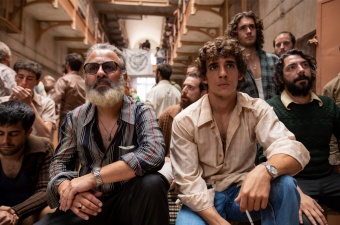Prison 77
Modelo 77
VERDICT: Director Alberto Rodriguez grippingly reconstructs the post-Franco years, using historical riots and prisoners demanding human rights as a microcosm of Spain as it made a screeching transition from fascism to democracy.
Recounting Spanish society in the difficult years following the death of dictator Francisco Franco in 1975, Prison 77 (Modelo 77) makes double use of prison life as a metaphor and an example of the constraint, brutality and arrogance of a period that, in reality, was fading to black while a democratic society gradually took its place. Alberto Rodriguez moves scores of actors through sharply defined roles that make each of the prisoners count. Though many members of the audience may buy a ticket to see a fast-paced, violence-strewn prison picture (and they won’t be disappointed), everyone should come away with a better understanding of the grueling frustrations inherent in living through a time when society is changing gears and the promised land of democratic freedom from oppression seems to recede rather than come closer.
The Seville-born Rodriguez is one of Spain’s top filmmakers and his early career as an action and crime director is put to good use here. But Prison 77 falls more into the mold of his award-winning Marshland (La isla minima) 2014 and the 2016 true spy story Smoke & Mirrors (El hombre de las mil caras), which took action up an octave to encompass larger questions facing Spanish society. Both, like the present film, were co-written by regular collaborator Rafael Cobos. Buena Vista International is releasing the film this week in Spain after it opened the San Sebastian Film Festival. Given its domestic theme, it should see its main chance in related Euro markets.
The story opens in 1976, three months after Franco has died, and the day that curly-haired, 30-year-old accountant Manuel (Miguel Herran) enters the Modelo prison in Barcelona, which vies with him as the film’s central character. Built for 800 prisoners in 1904 (and cramming in 13,000 inmates during the Spanish Civil War), it is in the shape of a starfish with six tentacles radiating out from a central dome. Photographing the structure as a study in light and shadow, D.P. Alex Catalan emphasizes its odd resemblance to a deformed church. Although Manuel has embezzled just 50,000 pesos, his crooked employer has had him sentenced for one million, pocketing the rest and letting the clean-cut young man pay for the bigger crime. His ideas about prison are foggy – for example, he refuses to sell his well-cut suit to a guard for 250 pesos and it is soon ripped off him by other inmates – but the first of many hard-to-watch beatings and a spell in solitary clear his head.
One of these beatings at the hands of guards armed with batons leads to his acquaintance with Boni, a queer doctor who has been jailed for his sexuality, and Blacky, a jovial, generous fixer who whispers to Manuel encouragingly, “you are not alone!” In fact, the cells may seem impossibly isolated, but there is an underground movement calling for better prison conditions and amnesty that unites all six cell blocks and a full range of detainees, from white collar criminals like Manuel and gay men to anarchists, socialists and communists, all the way to the murderers and drug lords of Cell Block 6. Each character is given personality and individuality and some are unforgettable, like the drug boss Marbella whose offer to join the clandestine Prisoners Rights Association is met with stony silence.
In these momentous years, Manuel emerges as a leader in spite of himself. Seized by passion and the pain he’s been through, he launches hand-written leaflets demanding humane treatment during an impressively massive prison riot, staged with a feeling for excitement and tension. As the camera rises over the prison’s cupola, there is a breath-taking shot of masses of supporters protesting outside the prison and reading the leaflets blown by the wind, a stirring image of solidarity that takes the viewer by surprise.
Sharing Manuel’s harsh, violent life inside the cellblock is Pino (Javier Gutiérrez), a tough prison veteran who calls the shots in the cell and who rents out his collection of well-thumbed sci-fi paperbacks. The two men’s shifting relationship is never banal and is surprisingly long-lived, given what they go through. The only characters who are deliberately reduced to faceless ciphers are the guards, whose propensity for sadism makes them blend into each other (and even more so, the robotic hordes of suited riot police who are the deadliest of all.) The ending is unexpected, especially as it follows true events. In the ending title sequence one can see the real people who have been depicted, in messy black and white photographs from the Seventies,
The ambitious production balances the realism of the actors in expressing the unhappiness of confinement with the extraordinary sense of soaring space in the old prison, where the living spaces of the prisoners are dark, while light coming from windows high overhead teases them with freedom. The pace is consistently fast without disturbing the narrative thanks to editor José M. G. Moyano, though towards the end of this two-hour film chock full of characters, there are certain moments of repetition (the transfer from one prison to another is one example) that lower the gripping tension.
Director: Alberto Rodriguez
Screenplay: Rafael Cobos, Alberto Rodriguez
Cast: Miguel Herran, Javier Gutiérrez, Jesus Carroza, Fernando Tejero, Catalina Sopelana, Xavi Saez
Producers: Domingo Corral, José Antonio Félez Aznar, Cristina Sutherland, Alberto Félez de Torres
Cinematography: Alex Catalan
Editing: José M. G. Moyano
Costume design: Fernando Garcia
Music: Julio de la Rosa
Sound: Daniel de Zayas
Production companies: Atipica Films (Spain), Telefonica Audiosisual Digital Slu (Spain)
World Sales: Film Factory Entertainment (Spain)
Venue: Venice Film Festival (Competition)
In Spanish
125 minutes






